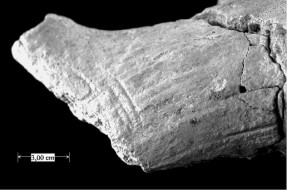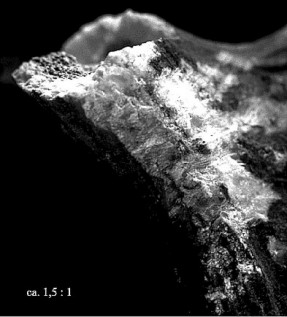
Fig. 30: 3 parallel traces, about 1 cm below the break on the lateral side the antler basis of reconsructed unit No. 75).
Controlled fragmentation of antlers usually leaves signs of the antler having been intentionally weakened by for instance, cut, chop, saw or carving marks. Another method of weakening an antler would be to heat it. No such marks pointing to controlled and intentional antler weakening in order to produce tool blanks, occur in the Bilzingsleben material.

Fig. 30: 3 parallel traces, about 1 cm below the break on the lateral side the antler basis of reconsructed unit No. 75).
Mania (1986b) mentioned the occurrence of chop marks in several cases as, for example, the traces close to the fracture in refit 75 and illustrated in Mania 1986b (Taf. 108). The fracture was observed during refitting in the form of a stepped fracture along the beam near the second tine - similar fractures can be observed in the same area of other antler fragments. Three almost parallel scratches at about 10mm below the fracture on the lateral side of the antler base (Fig. 30) were interpreted as chop marks from intentional blows leading to the disintegration of the lower beam. However, deliberate action cannot be assumed on the presence of these traces. The area where the fracture occurred would, as also Mania commented (1986b), rather point to a more destructive process. Experiments were carried out to simulate possible ways of intentionally fracturing antlers and shaping antler tools. They showed that three blows alone are insufficient to break an antler or to remove a tine, even when using a heavy duty tool and leaving reasonable chop marks. Many more blows are necessary to weaken the antler (Fig. 31).

Fig. 31: Experimentally produced traces with a heavy duty tool, bez tine area.
In addition, when viewed under a microscope, chop marks are accompanied by fields of parallel scratches, the kind of which are not present in the area of the three scratches seen on the antler base of unit No. 75. Fracturing therefore probably occurred through actions other than chopping with a heavy-duty tool.
Uncontrolled fragmentation of antlers is theoretically another way to produce pieces of antler. Experiments with a heavy travertine slab (about 70kg) thrown onto intact antlers showed that fragmentation by this method is possible. The big fragments broke off from the structurally weak areas of an antler, for instance the upper beams often break off below the trez tine, and depending on which side of the antler was positioned on a stone anvil, one of the lower tines also regularly break off. The traces left on the antler surface by this uncontrolled method are surprisingly few. On the other hand, fragmentation of antlers by this method also produce a high number of antler fragments with a particular break feature, called 'Bruchlippen' in German (Fig. 32; see also Conard 1992; Tinnes 1994). Bruchlippen do not occur in the Bilzingsleben antler material.

Fig. 32. 'Bruchlippen', produced experimentally during uncontrolled fragmentation of antler.
Using the terminology of Villa and Mahieu (1991), break patterns of the Bilzingsleben antler material can be described according to their morphological position. Antler fragments with incomplete beam circumferences were excluded (11% of the material) and fractures of refit units were counted separately. A third group of antler fragments broken by the impact of sediment overburden on structurally weakened antler parts, which had been glued together during excavation, was also counted separately and served as a comparative group. Overall, break patterns on the main beam elements (Table 5), as well as on their associated tine bases (Table 6), are relatively uniform.
| Fracture angle | oblique | perpendicular | oblique + perpendicular |
| Main beams | 70.1 % | 18% | 11.4% |
| Main beams, refitted | 56.1% | 21.9% | 21.9% |
| Main beams, glued | 66.1% | 30.8% | 3.2 % |
| Fracture outline | transversal | curved | intermediate |
| Main beams | 14% | 58.5% | 27.4% |
| Main beams, refitted | 23.1% | 64 % | 12.8% |
| Main beams, glued | 26.9% | 62.2% | 15.2% |
| Fracture edge | smooth | rough | jagged |
| Main beams | - | 61.4% | 38.4% |
| Main beams, refitted | 7.5% | 67.5% | 25% |
| Main beams, glued | 1.2% | 83.8% | 15.1% |
| Fracture angle | oblique | perpendicular | oblique + perpendicular |
| Tines connected with main beams | 49.7 % | 15.2% | 35% |
| Tines connected with main beams, refitted | 48% | 22% | 30% |
| Tines connected with main beams, glued | 67.3% | 16.3% | 16.3 % |
| Fracture outline | transversal | curved | intermediate |
| Tines connected with main beams | 11.9% | 55.6% | 32.5% |
| Tines connected with main beams, refitted | 21.6% | 51 % | 27.5% |
| Tines connected with main beams, glued | 16.3% | 67.3% | 16.3% |
| Fracture edge | smooth | rough | jagged |
| Tines connected with main beams | 1.9% | 51.7% | 46.4% |
| Tines connected with main beams, refitted | - | 60% | 40% |
| Tines connected with main beams, glued | - | 71.4% | 28.6% |
The similar relative frequencies of observed break patterns in the different groups (including the control group) suggest that an agent other than simple sediment weight cannot necessarily be deduced from the available evidence. In other words, break patterns alone do not provide conclusive evidence of intentional modification of antlers at Bilzingsleben by hominids.
© Internet Archaeology
URL: http://intarch.ac.uk/journal/issue8/vollbrecht/en/8.html
Last updated: Thu Aug 10 2000